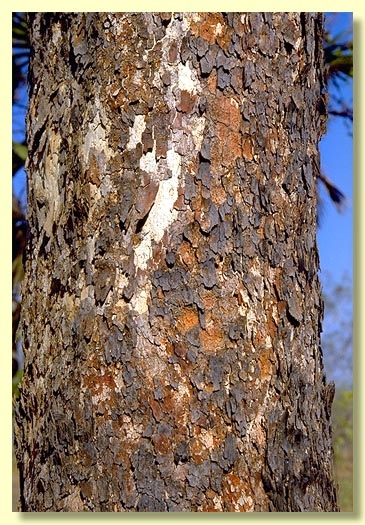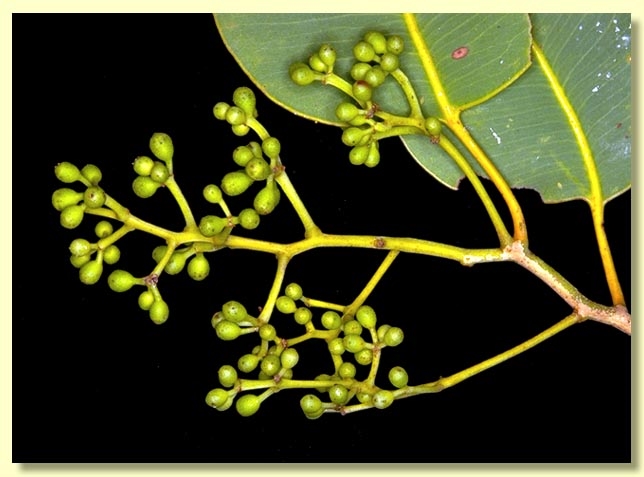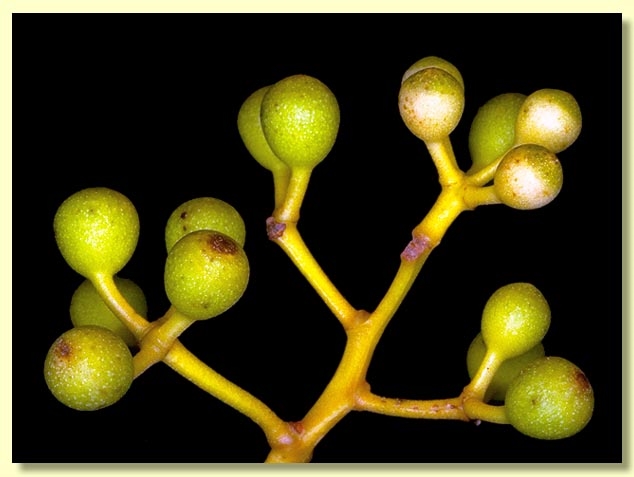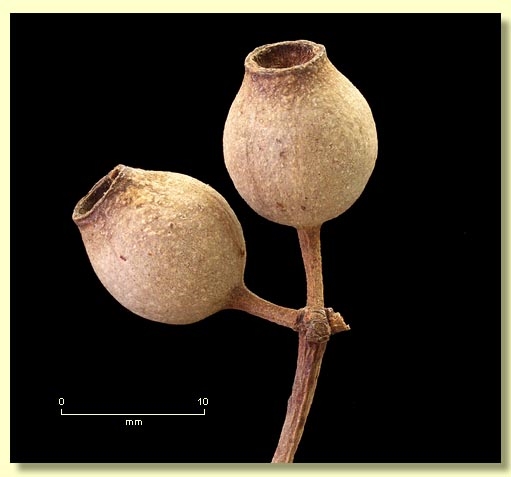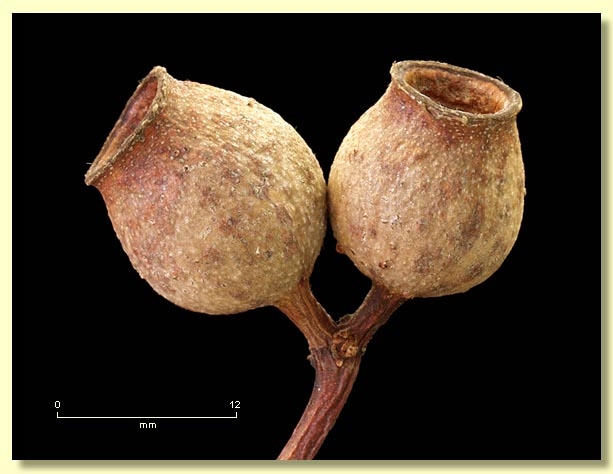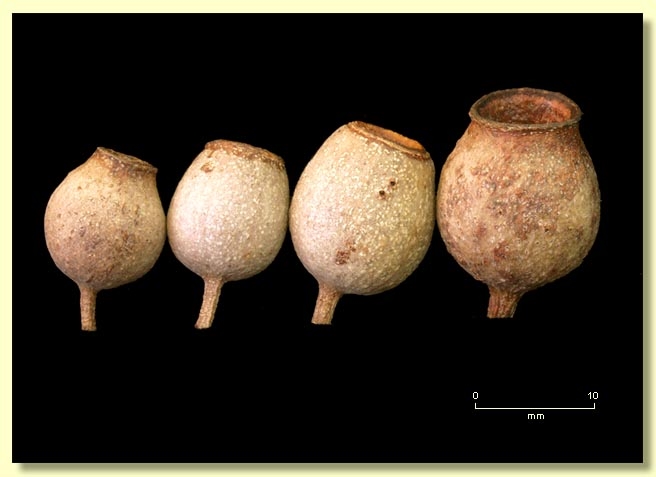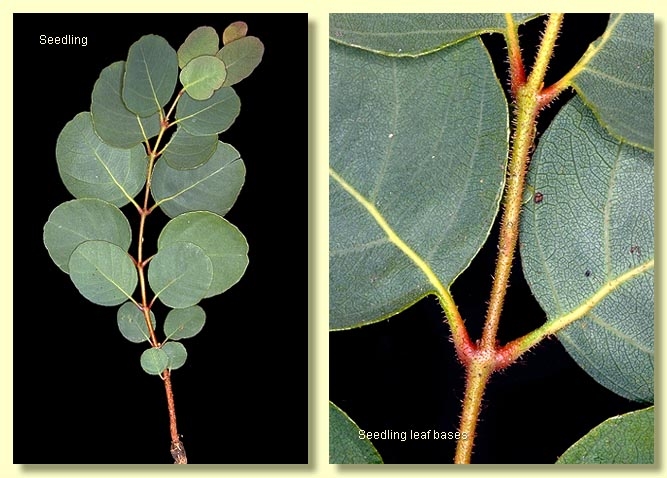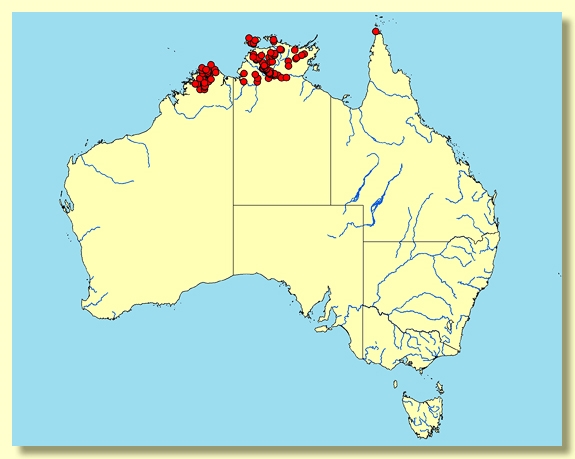Euclid - Online edition
Corymbia latifolia
Corymbia | Rufaria
Tree to 12 m tall. Forming a lignotuber. Dry season deciduous.
Bark usually thin and rough, scaly to coarsely tessellated, orange-brown, variously persistent over the lower trunk, rarely the whole trunk and larger limbs, smooth white to cream and grey above.
Branchlets lack oil glands in the pith.
Juvenile growth (coppice or field seedlings to 50 cm): stems rounded in cross-section, smooth; juvenile leaves always petiolate, opposite for a few nodes then sub-opposite, large, orbicular to broadly ovate less commonly ± oblong, (6.5)8.5–22.5 cm long, (4.5)8–14 cm wide, base rounded to truncate or tapering, apex emarginate, margin usually crenulate, dull, green, smooth.
Adult leaves alternate, petioles (1.7)2–5 cm long; blade deltoid to broadly ovate or elliptical, rarely some leaves broadly lanceolate, 7–16.5 cm long, 4–12.3 cm wide, base truncate to rounded or tapering, margin entire, apex rounded and apiculate or pointed, concolorous or only slightly discolorous, dull, green, smooth, side-veins at greater than 45° to midrib (penniveined), reticulation very dense, intramarginal vein apparently absent (confluent with margin) or rarely visible and very close to margin, oil glands apparently absent.
Inflorescence terminal compound, peduncles slender, slightly angular, 0.2–2.2 cm long, buds 7 per umbel, pedicels slender, 0.2–1.3 cm long. Mature buds obovoid to pyriform or almost globular, 0.5–0.6 cm long, 0.3–0.6 cm wide, smooth and ± glossy, scar absent (both opercula shed together at flowering), operculum shallowly rounded and sometimes apiculate, stamens inflexed, all fertile, anthers oblong, dorsifixed, versatile, dehiscing by longitudinal slits, style long, straight, stigma blunt or with a fringe of papillae, locules 3 or 4, the vertical ovule rows indistinct on the placentae. Flowers creamy white.
Fruit pedicellate or sometimes subsessile (pedicels 0–1 cm long), urceolate with a very short neck or neck lacking, rim scarcely flared, 0.8–1.4 cm long, (0.7)0.8–1.2(1.3) cm wide, smooth, disc descending vertically, valves 3 or 4, enclosed.
Seeds brown, 5–8 mm long, ellipsoidal with terminal wing, hilum ventral.
Cultivated seedlings (measured at ca node 10): cotyledons large, reniform; stems rounded in cross-section, setose with long and short bristle-glands; leaves always petiolate (petioles to 1 cm), opposite for at least 14 nodes, or sometimes sub-opposite earlier, broadly elliptical to ovate or orbicular, 3.5–7 cm long, 2–5.5 cm wide, base rounded to truncate or tapering, margin subcrenulate or less commonly entire, apex emarginate or rounded, green, slightly discolorous, setose with bristle-glands especially on midrib on underside, sparse elsewhere.
Flowering has been recorded in January, February, March, November and December.
A small tree widespread in monsoonal northern Australia, from the north-western Kimberley region, the Top End of the Northern Territory, including Melville, Bathurst and Copeland Islands, and the tip of Cape York Peninsula and nearby Prince of Wales Island. It extends into lowland southern Papua New Guinea. Corymbia latifolia prefers low-lying level sites with heavier clayey or loamy soils and has scaly thin rough bark on at least part of the trunk, a crown of relatively large dull ovate leaves and small urceolate fruit less than 1.3 cm diameter.
In the Northern Territory C. latifolia can be confused with the large-leaved endemic species C. foelscheana but has smaller fruit with a less prominent neck (fruit of C. foelscheana > 1.3 cm diameter). C. foelscheana also prefers shallower soils. In other areas of its natural distribution C. latifolia is distinctive because of its large broadly ovate leaves.
MORE ABOUT CORYMBIA
MORE ABOUT RED BLOODWOODS
Corymbia latifolia: Latin latus, broad or wide and folium, leaf.


